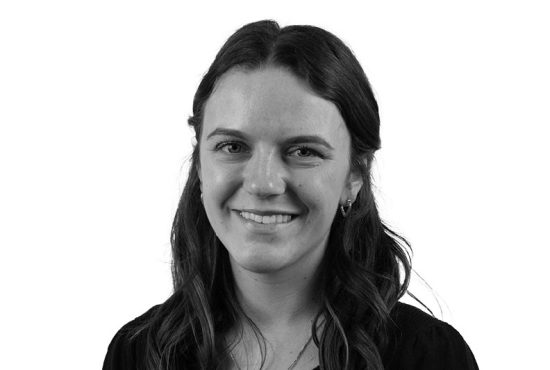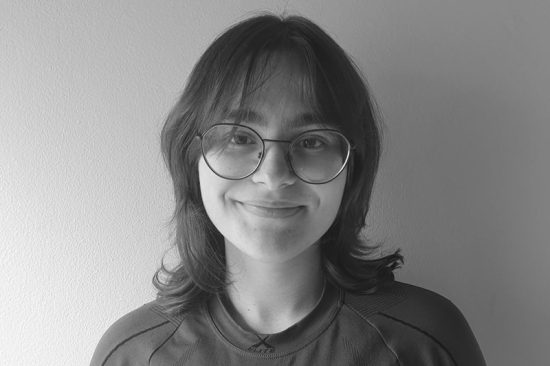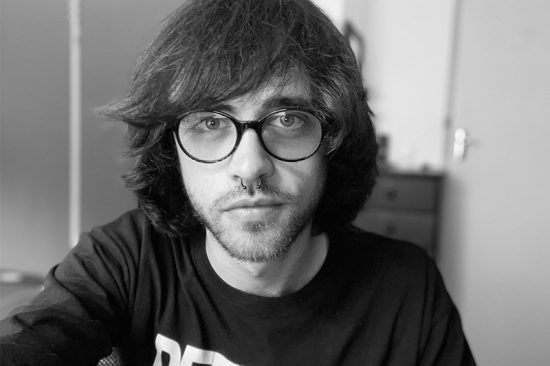
Vianey Diaz is a Houston-based graphic designer that specializes in print and motion design. Her work is influenced by minimalistic Swiss design and the grunge aesthetics of the new wave and punk era. She aspires to create unconventional, highly experimental designs in the same realm as designers like Wolfgang Weingart and David Carson.
“People who are for AI are claiming that it’s democratizing art or something. But art’s always been a democracy. It’s always been so accessible to anybody.”
TPP45S Of the forty-five visuals you created, which is your favorite? Why?
VIANEY DIAZ Number ten [35°20’53.5”N, 80°44’00.6”W] and forty-two [31°12’29.3”N, 121°30’06.9”E]. [I like them] because of how they look visually—a lot went into creating them. If you look their infrastructures up on Google Maps, they’re huge, huge highway interchanges. But you don’t really see that from eye level. They have such an interesting pattern when you look at them from a bird’s eye view [which is conveyed in their symbols.]
.

35°20’53.5”N, 80°44’00.6”W [10 of 45]

31°12’29.3”N, 121°30’06.9”E [42 of 45]
TPP45S Why do you think an artifact from the past could be relevant to you and your creative practice?
VIANEY DIAZ It could be a source of inspiration—just looking at stuff from the past and reinterpreting them into your own time to see how different it would be or how it relates to you or your environment.
TPP45S Your winning project Carbon Fingerprint, threads the infrastructure of the world’s super highways into human fingerprints. You mentioned in your artist statement that you drove on some of the highways depicted in the forty-five symbols. Were driving on those highways the initial inspiration for this project?
VIANEY DIAZ Maybe partly. I’ve lived in Texas for most of my life and really intricate highways are pretty common here—especially in Houston. When you’re looking at them from the ground, they look brutalist. But, in a similar way to crop circles, when you look at them from above they make these really pretty patterns.
Initially, when I was searching for a topic to do [for the project], my first thought was to look at stuff from a satellite’s point of view. That’s how I got onto Google Images. I had already had a previous interest in how highways looked from a ground view. So when I saw them from above, I was like, huh, these look kinda like fingerprints. And then from there I built a narrative around that [idea].

TPP45S You contrast the excessiveness of super highways structures with the delicate nature of the fingerprints. Is excessiveness versus delicacy an element that is often featured in your design?
VIANEY DIAZ In my design work, I do have an interest in line art. I really like minimalistic looking things. So that usually entails delicate lines and geometric shapes—at a subconscious level I naturally gravitate towards those delicate, delicate lines that are simple, but when you start adding more to them turn into something complex.
TPP45S Instead of naming the symbols after the highways they represent, you chose to name them after the highways’ geographical coordinates. Why did you make this choice?
VIANEY DIAZ I think mainly for two reasons. One of them is that I really like playing with contrasting typography against images. I especially like delicate typography against big images. The second, is I was thinking it could be sort of audience participation. People could look at the symbols and go “Hm, I wonder if this is actually something I could look up.” If you put these [the forty-five symbols’] coordinates in Google Maps, then it’ll take you straight to the highways that these fingerprints are [patterned after].
TPP45S What does your project tell audiences of today and tomorrow about our current anthropocene and human impact on our planet?
VIANEY DIAZ We drive a lot. We have an overreliance on cars. We build more and more of these roads, but it just exacerbates the problem.
TPP45S Where did the fingerprints in this project come from?
VIANEY DIAZ At first, I was just going to do line work of the [bird’s eye view] highway intersections, but it felt too sparse. I wanted something that looked a little bit more full. So after thinking about how much they looked like fingerprints, I started adding these [fingerprint-like] lines around the highway infrastructures to flesh the symbols out. The fingerprints themselves are partially real and partly my imagination.
I looked at pictures of actual fingerprints, and I looked at mine a lot. I played with ink and pressed my fingerprints to study them. I incorporated the textures I made [with the ink] into the project’s actual fingerprints so they have this kind of faded look to them. So there’s a little piece of me in every one of the symbols.

TPP45S In Carbon Fingerprint, you aim to portray how, the faster humans develop industrially, the more pollution we create—which causes us to further damage our ecosystem. Do you feel like industrial development’s effects on our ecosystem will continue to influence future designers’ works?
VIANEY DIAZ If we still struggle to balance advancing technology with our ecosystem—with nature–I’m sure somebody will be. There’s always been designers who are also activists and that’s a trend that exists now and will continue.
TPP45S What do you believe are the biggest challenges of this upcoming generation of visual artists/designers?
VIANEY DIAZ The first thing that pops into my head is AI. I’ve seen a whole lot of discussion around that. How people who are for AI are claiming that it’s democratizing art or something. But art’s always been a democracy. It’s always been so accessible to anybody. But, anyways, there’s just a lot of back and forth. And then there’s people saying it’s going to completely replace creatives and all that. But I think it could be a really useful tool for designers and artists. It’s just the problem of making sure it’s regulated and not being used to steal from artists.
TPP45S The humans who created the Phaistos Disc—if it’s not a hoax—will never be able to tell us what its forty-five symbols mean. But you are here with us today, to talk about your own set of forty-five symbols. What is it that you hope people take away from your project?
VIANEY DIAZ I hope that people see how ridiculously intricate these highway interchanges are, and that the symbols make people self aware of our overreliance on cars. And maybe with that in the back of our head, maybe then we can collectively make a change.

VIANEY DIAZ
Vianey Diaz is a Houston-based graphic designer that specializes in print and motion design. Her work is influenced by minimalistic Swiss design and the grunge aesthetics of the new wave and punk era. She aspires to create unconventional, highly experimental designs in the same realm as designers like Wolfgang Weingart and David Carson.
Carbon Fingerprint
Winning Project Open Call 22/23



